From Wikipedia, the free encyclopedia
Stauromedusae
Coronatae
Semaeostomeae
Rhizostomae |
Jellyfish are marine invertebrates belonging to the class Scyphozoa of the phylum Cnidaria. They can be found in every ocean in the world and even in some fresh water. The name “jellyfish” is also applied to some close relatives of true scyphozoans, such as the Hydrozoa and the Cubozoa. Jellyfish live in groups called ‘Bondamines’
[edit] Anatomy and morphology

A typical medusoid-phase jellyfish.
The body of a jellyfish consists of a bell shape producing jelly and enclosing its internal structure, from which tentacles are suspended. Each tentacle is covered with cells called cnidocytes, that can sting or kill other animals. Most jellyfish use these cells to secure prey or for defense. Others, such as the Rhizostomae, do not have tentacles at all. They have many small eyes on their bell which give them a 360A?A? field of vision.
Jellyfish lack basic sensory organs and a brain, but their nervous systems and rhopalia allow them to perceive stimuli, such as light and odour, and respond quickly. They feed on small fish and zooplankton that become caught in their tentacles. Most jellyfish are passive drifters and slow swimmers, as their shape is not hydrodynamic. Instead, they move so as to create a current forcing the prey within reach of their tentacles. They do this by rhythmically opening and closing their bell-like body. Their digestive system is incomplete: the same orifice is used to take in food and expel waste. The body of an adult is made up of 94A?a??a??98% water. The bell consists of a layer of epidermis, gastrodermis, and a thick, intervening layer called mesoglea that produces most of the jelly.
[edit] Body systems
A jellyfish detects the touch of other animals using a nervous system called a “nerve net“, located in its epidermis. Touch stimuli are conducted by nerve rings, through the rhopalial lappet, located around the animal’s body, to the nerve cells. Jellyfish also have ocelli: light-sensitive organs that do not form images but are used to determine up from down, responding to sunlight shining on the water’s surface. They also sting when another organism touches their tentacles.
Jellyfish don’t have specialized digestive, osmoregulatory, central nervous, respiratory, or circulatory systems. They digest using the gastrodermal lining of the gastrovascular cavity, where nutrients are absorbed. They do not need a respiratory system since their skin is thin enough that the body is oxygenated by diffusion. They have limited control over movement and mostly free-float, but can use the hydrostatic skeleton of the water pouch to accomplish vertical movement through pulsations of the disc-like body.
The outer side of a jellyfish is lined with a jelly-like material called ectoplasm (ecto meaning outer and plasm meaning living matter). The ectoplasm typically contains a smaller amount of protein granules and other organic compounds than inner cytoplasm, also referred to as endoplasm (endo meaning inner).
[edit] Jellyfish blooms
Many species of jellyfish are capable of congregating into large swarms or “blooms”, consisting of hundreds of individuals. The formation of these blooms is a complex process that depends on ocean currents, nutrients, temperature and ambient oxygen concentrations. Jellyfish sometimes mass breed during blooms. During such times of rapid population expansion, some people will raise ecological concerns about the potential noxious effects of a jellyfish “outbreak”.
According to Claudia Mills of the University of Washington, the frequency of jellyfish blooms may be attributed to humans’ impact on marine systems. She says that the breeding jellyfish may merely be filling ecological niches formerly occupied by overfished creatures. Jellyfish researcher Marsh Youngbluth further clarifies that “jellyfish feed on the same kinds of prey as adult and young fishes, so if fish are removed from the equation, jellyfish are likely to move in.”
Increased nutrients in the water, ascribed to agricultural runoff, have also been cited as an antecedent to the proliferation of jellyfish. Monty Graham, of the Dauphin Island Sea Lab in Alabama, says that “ecosystems in which there are high levels of nutrients … provide nourishment for the small organisms on which jellyfish feed. In waters where there is eutrophication, low oxygen levels often result, favoring jellyfish as they thrive in less oxygen-rich water than fish can tolerate. The fact that jellyfish are increasing is a symptom of something happening in the ecosystem.”[1]
By sampling sea life in a heavily fished region off the coast of Namibia, researchers found that jellyfish have overtaken fish in terms of biomass. The findings represent a careful, quantitative analysis of what has been called a “jellyfish explosion” following intense fishing in the area in the last few decades. The findings were reported by Andrew Brierley of the University of St. Andrews and his colleagues in the July 12, 2006 issue of the journal Current Biology.
Areas which have been seriously affected by jellyfish blooms include the northern Gulf of Mexico. In that case, Graham states, “Moon jellies have formed a kind of gelatinous net that stretches from end to end across the gulf.”[1]
[edit] Life history
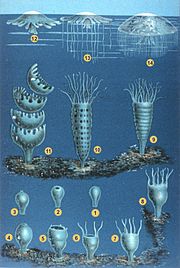
The developmental stages of jellyfish.
Most jellyfish pass through two distinct life history phases (body forms) during their life cycle. The first is the polypoid stage, when the jellyfish takes the form of either a sessile stalk which catches passing food, or a similar free-floating configuration. The polyp’s mouth and tentacles face upwards, reminiscent of the hydroid stage of the somewhat closely related anthozoan polyps, also of the phylum Cnidaria. The polyp will then move around until it attaches itself to a suitable home.
In the second stage, the jellyfish is known as a medusa. Medusae have a radially symmetric, umbrella-shaped body called a bell. The medusa’s tentacles are fringe-like protrusions from the border of the bell. (Medusa is also the word for jellyfish in Portuguese, Romanian, Hebrew, Serbian, Croatian, Spanish, French, Italian, Hungarian, Russian and Bulgarian.)
Jellyfish are dioecious; that is, they are either male or female. In most cases, to reproduce, a male releases his sperm into the surrounding water. The sperm then swims into the mouth of the female, allowing the fertilization of the ova. However, moon jellies use a different process. The eggs become lodged in pits on the oral arms, which form a temporary brood chamber to accommodate fertilization.
After fertilization and initial growth, a larval form, called the planula, develops from the egg. The planula is a small larva covered with cilia. It settles onto a firm surface and develops into a polyp. The polyp is cup-shaped with tentacles surrounding a single orifice, resembling a tiny sea anemone. After an interval of growth, the polyp begins reproducing asexually by budding and is called a segmenting polyp, or a scyphistome. New scyphistomae may be produced by budding or new, immature jellies called ephyra may be formed. Many jellyfish species are capable of producing new medusae by budding directly from the medusan stage.
Most jellyfish have a lifespan of two and a half months; few live longer than six months but one species can live as long as 30 years and another species, T. nutricula, is effectively immortal.
[edit] Etymology and taxonomic history
Since jellyfish are not fish, some people consider the term “jellyfish” a misnomer, and instead use the term “jellies” or “sea jellies”. The word “jellyfish” is also often used to denote either hydrozoans or the box jellyfish, the cubozoans. The class name, Scyphozoa, comes from the Greek word skyphos, denoting a kind of drinking cup and alluding to the cup shape of the organism.
A group of jellyfish is often called a “smack”. [2]
[edit] Importance to humans
[edit] Culinary uses
Jellyfish are an important source of food to the Chinese community and in many Asian countries.[3] Only jellyfish belonging to the order Rhizostomeae are harvested for food. Rhizostomes, especially Rhopilema esculentum in China (Chinese name: A?A?A?A?A?a?? hA?A?izhA?a??, meaning “sea sting”) and Stomolophus meleagris (cannonball jellyfish) in the United States, are favoured because they are typically larger and have more rigid bodies than other scyphozoans. Furthermore, their toxins are innocuous to humans.[3]
Traditional processing methods, carried out by a Jellyfish Master, involve a 20 to 40 day multi-phase procedure in which the umbrella and oral arms are treated with a mixture of table salt and alum, and compressed.[3] The gonads and mucous membranes are removed prior to salting. Processing reduces liquidation, off-odors and the growth of spoilage organisms, and makes the jellyfish drier and more acidic, producing a “crunchy and crispy texture.”[3] Jellyfish prepared this way retain 7-10% of their original, raw weight, and the processed product contains approximately 95% water and 4-5% protein, making it a relatively low calorie food.[3] Freshly processed jellyfish has a white, creamy color and turns yellow or brown during prolonged storage.
In China, processed jellyfish are desalted by soaking in water overnight and eaten cooked or raw. The dish is often served shredded with a dressing of oil, soy sauce, vinegar and sugar, or as a salad with vegetables.[3] In Japan, cured jellyfish are rinsed, cut into strips and served with vinegar as an appetizer.[3][4] Desalted, ready-to-eat products are also available.[3]
Fisheries have begun harvesting cannonball jellyfish along the southern Atlantic coast of the United States and in the Gulf of Mexico for export to Asian nations.[3]
[edit] In biotechnology
In 1961, green fluorescent protein (GFP) was discovered in the jellyfish Aequorea victoria by scientists studying bioluminescence. This protein has since become a quite useful tool in biology. Its use is mainly for scientists studying in which tissues genes are expressed. The technique, using genetic engineering, fuses the gene of interest to the gene of GFP. The fused DNA is then put into a cell, to generate either a cell line or (via IVF techniques) an entire animal bearing the gene. In the cell or animal, the artificial gene gets turned on in the same tissues and the same time as the normal gene. But instead of making the normal protein, the gene makes GFP. One can then find out what tissues express that protein — or at what stage of development — by shining light on the animal or cell, and looking for the green fluorescence. The fluorescence shows where the gene of interest is expressed.[5] Jellyfish are also harvested for their collagen, which can be used for a variety of scientific applications including the treatment of rheumatoid arthritis.
[edit] In captivity
Jellyfish are commonly displayed in aquaria in many countries. Often the tank’s background is blue and the animals are illuminated by side light to produce a high contrast effect. In natural conditions, many jellies are so transparent that they are almost impossible to see.
Holding jellyfish in captivity presents other problems. For one, they are not adapted to closed spaces. They depend on currents to transport them from place to place. To compensate for this, professional exhibits feature precise water flows, typically in circular tanks to prevent specimens from becoming trapped in corners. The Monterey Bay Aquarium uses a modified version of the kreisel (German for “spinning top”) for this purpose.
[edit] Toxicity to humans
When stung by a jellyfish, first aid may be needed immediately. The stings of true Scyphozoan jellyfish are not generally deadly, though species of the completely separate class Cubozoa (box jellyfish) such as the famous and especially toxic Irukandji can be fatal. However, even nonfatal jellyfish stings are known to be extremely painful. Serious stings may cause anaphylaxis and may result in death. Hence, people stung by jellyfish must get out of the water to avoid drowning. In serious cases, advanced professional care must be sought. This care may include administration of an antivenin and other supportive care such as required to treat the symptoms of anaphylactic shock.
There are three goals of first aid for uncomplicated jellyfish stings: prevent injury to rescuers, inactivate the nematocysts, and remove any tentacles stuck on the patient. To prevent injury to rescuers, barrier clothing should be worn. This protection may include anything from panty hose to wet suits to full-body sting-proof suits. Inactivating the nematocysts, or stinging cells, prevents further injection of venom into the patient.
Vinegar (3 to 10% aqueous acetic acid) should be applied for box jellyfish stings.[6][7] Vinegar, however, is not recommended for Portuguese Man o’ War stings.[6] In the case of stings on or around the eyes, vinegar may be placed on a towel and dabbed around the eyes, but not in them. Salt water may also be used in case vinegar is not readily available.[6][8] Fresh water should not be used if the sting occurred in salt water, as a change in pH can cause the release of additional venom. Rubbing the wound, or using alcohol, spirits, ammonia, or urine will encourage the release of venom and should be avoided.[9] Though often not available, a shower or bath as hot as can be tolerated can neutralize stings. However, if hypothermia is suspected this method may cause other serious complications.
Once deactivated, the stinging cells must be removed. This can be accomplished by picking off tentacles left on the body.[9] First aid providers should be careful to use gloves or another readily available barrier device to prevent personal injury, and to follow standard universal precautions. After large pieces of the jellyfish are removed, shaving cream may be applied to the area and a knife edge, safety razor, or credit card may be used to take away any remaining nematocysts.[10]
Beyond initial first aid, antihistamines such as diphenhydramine (Benadryl) may be used to control skin irritation (pruritus).[10] To remove the venom in the skin, apply a paste of baking soda and water and apply a cloth covering on the sting. If possible, reapply paste every 15-20 minutes. Ice can be applied to stop the spread of venom until either of these is available.
source:
http://en.wikipedia.org/wiki/Jellyfish
The Portuguese Man Of War Jellyfish is a very beautiful jellyfish that can be found in the tropical and subtropical regions like the Pacific and Indian Ocean. They have a very venomous sting that isn’t deadly, but very painful. The Portuguse Man of War Jellyfishes also called Physalia physalis is common in Hawaii and could be found in groups of hundreds or even thousands individuals. Actually it isn’t a jellyfish, but a Hydrozoan.
The Portuguese Man Of War Jellyfish is a very special creature. It’s said that it exists out of four individual organisms called Polyps. These Polyps work together to survive.
1.Pneumatophore is the part of the jellyfish that you see floating. It’s actually a balloon filled with gas (carbon monoxide) and you could see it very clearly on any picture.
2.Dactylozooids these are the tentacles of the jellyfish that are needed to catch a prays like fishes. Some of these arms are also used to bring the food to the feeding organism.
3.Gastrozooids the organism that digest all the food.
4.Gonozooids the organism that is used for the reproduction.
Like we mentioned before, the body of the Portuguese Man Of War mainly exist out of a gas filled organ (used as a sail) that can grow between 9 to 30 cm and can reach a height of 15 cm. Below this gas filled organ we find the tentacles (Dactylozooids) that can grow up to 50 meters in length! These are used to paralyze their pray and once they have caught a fish for example, then it will be digested by the Gastrozooids.
The Portuguese man Of War seems a good predator, but like many animals he has predators like the loggerhead turtle that eats him without hesitating about the venomous tentacles. However there are also animals that seek for protection like the Nomeus gronovii that also enjoys eating the tentacles of the jellyfish.
source:http://deepseamonsters.blogspot.com/2008/09/portugese-man-of-war-jellyfish.html
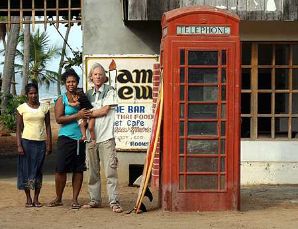
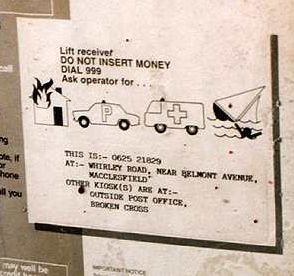
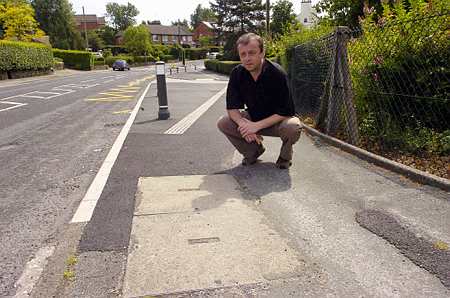
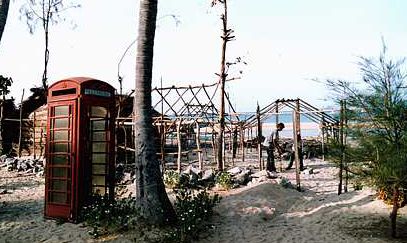





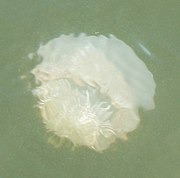










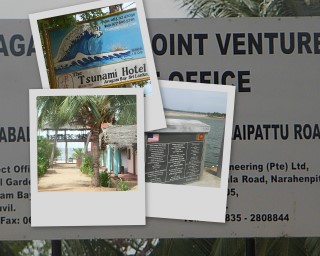

 Arugam Forum
Arugam Forum Arugam Photo Galleries on Picasa
Arugam Photo Galleries on Picasa Old Website
Old Website Press Coverage
Press Coverage Surf Forecast for Arugam Bay
Surf Forecast for Arugam Bay
TODAY’s Comments